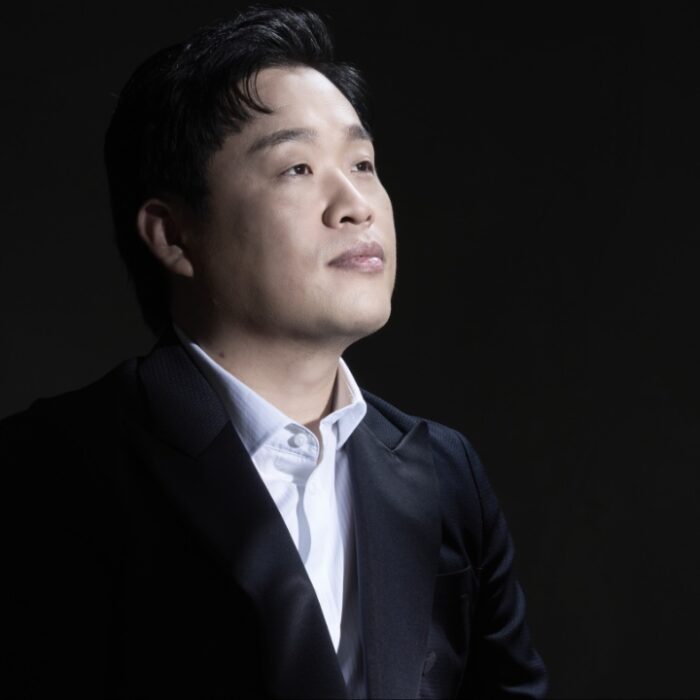
Q & A: Creative Duo Andrew Flack & Paul Fowler on Creating ‘Behold the Man’
By David SalazarIn 1930, Spanish painter Elías García Martínez created a fresco of Jesus crowned with thorns in the Santuary of Mercy Church in Borja. It was called “Ecce Homo” or “Behold the Man.”
Eighty-two years later, Cecilia Giménez, an 81-year-old amateur artist with minimal training, revealed to the media that she had attempted to restore the painting which had been affected by the moisture of the church.
What followed was something she could not imagine – a media storm of global proportions in which her attempted restoration was ridiculed with some even referring to it as “Ecce Mono” or “Behold the Monkey.” Subsequently, tourism in Borja has skyrocketed as interest in seeing the “botched restoration” increased.
The story inspired Andrew Flack and Paul Fowler who have now created an opera entitled “Behold the Man.” That very work, a comic opera, will premiere on Sept. 30, 2023 at Opera Las Vegas.
OperaWire had a chance to speak with the creators about how this story inspired them and their process in bringing it all together.
OperaWire: What was the inspiration for creating this opera? When did you first encounter the story of the botched “Ecce Homo” and why did that speak to you as a potential concept for an opera?
Andrew Flack: It’s August 2012 and I’m in Denver, Colorado, reading in The New York Times about an elderly amateur artist in Borja, Spain, who has taken it upon herself to “touch-up” a badly neglected and mostly deteriorated fresco of Jesus.
Her restoration hasn’t gone well. In fact, she wasn’t actually finished, but when it’s discovered she’s made to stop. By then the image has been swept up on social media and gone viral. And this poor woman has become the target of international mockery and neighborly scorn.
When I see her photograph my heart goes out to her. The artist’s name is Cecilia Giménez, clearly a woman of faith, and I can tell she’s stricken, horrified by what’s happened, that she’s ruined this work of art that’s been so dear to her. “Old Woman Ruins Priceless Masterpiece” blare the headlines.
So I call my composer friend, Paul Fowler, who’s been prodding me for years to come up with an idea for a comic opera. I tell him, Paul, this is it! A woman is villainized for ruining a rather insignificant fresco of Jesus, but the media’s over-sensationalized hubbub causes a tidal wave of tourism, which subsequently saves the town (which would actually be welcomed at this point given Spain’s economic suffering from “The Great Recession”).
I also tell Paul that I can see a silver lining up ahead. “There’s a happy ending here,” I tell him. “If they can just go with where this phenomenon is taking them.” And furthermore, I say, “When we’re finished with whatever it is we’re going to write, I want to see it performed in that little town.” Paul hoots at my audacity but says “Okay.”
OW: Walk me through the process of creating this opera. When did you start?
AF: A couple of weeks later Paul and I begin by having breakfast. Many breakfasts as it turns out, in pretty much every cafe between Denver and Boulder, where we were each living at the time. I would write a scene, order the chorizo burrito, and we’d discuss. I’d write another scene, Paul would order huevos rancheros, and we’d discuss.
Early on we decided “Behold The Man” would be our title, the English equivalent of “Ecce Homo,” the Latin phrase Pontius Pilate used on Good Friday to mock Jesus on his way to the cross, and the name given to the fresco itself.
Every week there were new stories coming out of Borja. The media couldn’t get enough of Cecilia, and neither could we. Her “Ecce Homo” had become the site of random, giddy pilgrimages. A destination for the holy “selfie,” a place you could brag about for having visited, or even just to stand beside something that was “famous” online. (And, as I found out, remote and not easy to get to!)
In the following weeks more stories would appear. Memes of Cecilia’s “Potato Head Jesus” circle the globe making it a bonafide Internet sensation. “Saturday Night Live” does a sketch with Kate McKinnon as Cecilia. Fan clubs are springing up. People in Barcelona and Madrid are marching in the streets to show Cecilia their support.
Back in Colorado, Paul and I are soaking all this up in real-time; adding the bits we think might work and inventing others to suit our dramatic needs. (The one character to whom we pledged our fidelity was Cecilia. Of the nine principal characters who take the stage, her’s is the only story drawn from “real life,” the only one whose dramatis personae closely aligns with her lived experience.) And slowly but surely, breakfast after breakfast, “Behold The Man” takes shape as we began to see the glimmer of a transformation underway in Borja. Amazingly, it’s mirroring the story of redemption we are already telling! Cecilia’s “Ecce Homo” has become a “thing,” and Paul and I are poised to go along for the ride.
OW: What were the specific challenges in creating the libretto?
AF: As we approached the anniversary of our first breakfasting, both acts are mostly outlined and maybe half of Act one has text and music. Paul’s music is beautiful. Absolutely beautiful. And perfectly suits the lyric and the Spanish locale where we find ourselves. (Paul will add more about this in his section.)
Admittedly, it was slow going. We both had other gigs and had committed to doing this primarily for the fun of it, and because Paul, who grew up in a household of musicians and opera singers, had always wanted to write an opera. (Paul’s a composer who’s also a singer, so his writing for singers makes him a natural. An incredibly talented guy.)
By now, September 2013, as we read that some 100,000 visitors from all seven continents have made the trek to Borja—and that thousands of Euros have been collected for charity—my partner, Barbara Duff, and I pack a bag and fly to Spain. It was time to see the “Ecce Homo” for ourselves. And meet Cecilia, if that could be arranged. (And it was…and we did…but that’s another story which will need a longer time for the telling.)
Let’s just say that after 48 hours in Borja I tell Barbara that if I die tonight in my sleep my life will be complete. We’ve had lunch with Borja’s mayor, interviewed the Santuario’s priest, and spent a few hours with Cecilia—who is as lovely and filled with the kind of grace I’d always imagined of her— and who shares with me her thoughts and feelings from the ordeal using the very words I have already used in her first aria. (For this reference, please check the libretto top of Act one, Scene three,…We agreed I would do this…”)
OW: How long did it take to get to a completed libretto and the subsequent score?
AF: Paul had warned me at the start of this journey that writing an opera would take a long time. And it did.
By July of 2014 we have finished Act one and we’re in a church in Boulder hosting our first 75-minute staged-reading. Paul is conducting. The audience is laughing. The audience is laughing a lot.
Later that month I write to Cecilia with a progress report. Her niece, Marisa Ibáñez, responds that the family is honored we’ve found inspiration in her aunt’s story—giving us their full blessing to continue on with the project—and with a promise to do whatever necessary to bring “Behold The Man” to Borja. (Things are looking up!)
In October 2014, I’m contacted by a journalist from the New York Times based in Paris. It seems Cecilia has spilled the beans to the Spanish press about what Paul and I are up to and this reporter wants to do a story of her own. She wants to go to Borja and interview all the principals. I make some long-distance introductions and she goes.
In December, a copy of the Times lies open on my table. The headline reads as if Paul and I have written it ourselves, “A Town, if Not a Painting, Is Restored.” I am quoted— “For me, it’s a story of faith. It’s a miracle how it has boosted tourism. Why are people coming to see it if it’s such a terrible work of art? God works in mysterious ways. Your disaster could be my miracle.”
From this reporting, countless other stories appear in countless other publications. But now the narrative has changed. Cecilia is no longer the target of ire for now the headlines read, “Smudge Becomes a Miracle”… ”Ecce Homo Tourism Monster”…etc.
By July of 2015, Act two is mostly complete and Paul and I host a second staged-reading of both acts. Within a week the international press is again hot on our heels with stories appearing all over Spain, the US, South America, Great Britain, Germany and Japan. But now the media’s focus is not only on Cecilia, Borja, and the “Ecce Homo” fresco, but on the opera itself, and its development.
And quietly, in the background, it’s Marisa, Cecilia’s niece, who has become our greatest ally, building a coalition of support in Borja to host the opera’s debut.
By December 2015, we’re home from our second visit to Spain. It was also during that visit that Borja’s mayor calls a press conference to announce the town’s commitment to produce the world premiere of “La Ópera del Ecce Homo.” (OMG! Now we’re gonna need a Spanish version, too?)
The following August, 2016, with just a half dozen scenes translated into Spanish, Borja’s mayor hosts an hour-long al fresco concert attended by 700 tourists and locals.
They had arranged outdoor seating for 400, but it didn’t seem to bother the other 300 who had to stand. It was a sensation. Television crews from all over Spain converged to beam back the story to their viewers. And the Times reporter again showed us some love with a piece about the event.
By 2017, with the English libretto and 95 percent of the score complete, we began working in earnest with a translator, then another translator, and yet a third translator to fashion a proper Spanish version which would retain the poetics and humor, and also fit the music so that not a single note of the score would need to be changed for either version. That process alone took a year-and-a-half.
Then in 2018 we had our first orchestral reading at Arizona State University. In 2019, placement in Ft. Worth Opera’s “Frontiers” workshop development week. And in 2021, a University Premiere by Wingate Opera in North Carolina.
And now, for the Opera Las Vegas World Premiere, Marisa will travel from Borja, and Paul and I will sit with her side-by-side-by-side. What a celebration it will be!
OW: What was your process for working together?
Paul Fowler: In the beginning, we met for breakfast in a different diner every few weeks — halfway between our homes in Denver and Boulder — and used that time to map out the opera with regard to scenes, plot points, and exciting prospects for duets, trios, ensemble and other comedic riffs. This was some of the most fun I’ve ever had, dreaming up our crazy piece. After that, Drew was fast at work developing the libretto. And as soon as he delivered scenes I would start writing music. I made little demos, singing all the parts, so that Drew and I could get a sense of mood and pacing and we’ve worked that way ever since. We make all the decisions about the piece together.
OW: What were the creative hurdles that you learned from?
PF: Translating the opera into Spanish was a big challenge. Trying to determine how important the melodies were versus the syllabic requirements of a different language. I really wanted to honor the natural flow of the Spanish, but I didn’t want to lose too much of the musical phrase. It was a long process, we used several translators in the beginning and when we found H.F. Pascual, we hit the jackpot. He was so generous, he would read all the scenes for me so that I could line up the stresses properly, and at the same time, he wrote his suggestions in the score… I’m very happy with how it turned out.
OW: Paul, what musical language did you employ for this work? What inspirations did he draw from?
PF: While our characters really drive the piece, the internet is the unseen force that sets everything in motion. So the opera is inspired by the incredible musical variety of the internet age. At the start each character has a distinct musical flavor: the church ladies and priest have a touch of Bach and Mozart, the rich diva sings Bel Canto, the teenagers sing pop, the smooth talking ghost of the painter sings Zarzuela and 50s lounge music, the mayor sings a traditional Jota… And as the internet starts influencing the townspeople, all these styles start banging against each other, like someone repeatedly hitting the “next” button on YouTube. Once the Ecce has gone viral, the opera becomes a palimpsest, constantly hinting at other music and artists — tango, flamenco, REM, Don Omar, Psy, Purcell, the Pixies…
OW: Finally, what do you hope audiences take away from the opera?
AF: From the beginning, the assignment we’d given ourselves was to make a comic opera. But Paul and I were also drawn to those bigger operatic themes like faith, love and forgiveness. For that reason, naturally, I hope the audience leaves with a smile. But also the sense that togetherness is always preferable to facing the unknown alone.
PF: I hope families walk away smiling, laughing, and thinking about miracles — Ceclila’s miracle, the miracle of the internet, the miracle of creativity…


